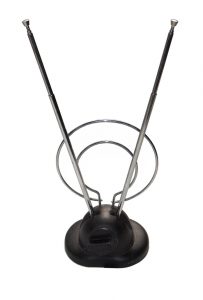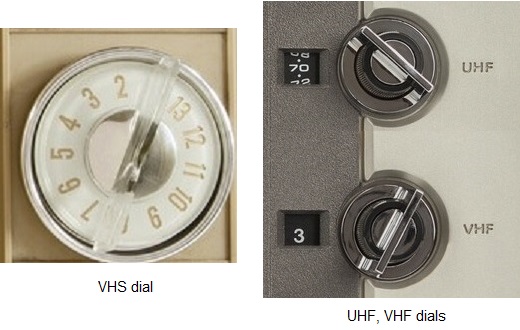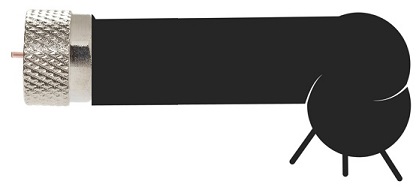Three things in life are absolute certainties:
- Death
- Taxes
- Cable/internet companies providing shitty service
Cable used to be far simpler.
We lived in Bisbee, Arizona from the late 1950s until the mid-1960s. The nearest television stations were 100 miles away in Tucson, far beyond the range of “rabbit ears” antennas, so rural communities like ours had Community Antenna Television (CATV). Several towers erected on Juniper Flats, a plateau on the mountain northwest of town, captured VHF (Very High Frequency) signals and distributed them to houses through coaxial cable. A small adapter allowed one to connect the cable to the two antenna terminals on the back of the TV and voilà! A great picture, no snow, no ghosts and no need to fiddle with a UHF ring tuner (that “U” on the dial). Everyone watched the same shows, and we liked it, dammit!

By 1970 cable had became more popular as many households ditched their antennas. The shift happened despite early FCC meddling and intimidating ads the networks aired in movie theaters decrying the evils of “pay TV.” Yet Home Box Office successfully launched in 1972 and has been with us for fifty years.

Televisions changed over the next several years. Manufacturers added a separate UHF dial as more channels became available, eventually replacing both dials with a single internal tuner. Cable connected directly to a coaxial port. Small children served as early channel changers, performing double duty as antenna adjusters. Actual remote controls evolved from wired (Zenith’s “Lazy Bones”) through primitive wireless (Zenith’s “Space Command” and Magnavox’s “pig whistle”) to ultrasonic and finally infrared.
Videotape became popular in the 1980s but with only one port available, the cable had to be routed through the player/recorder and then to the television. One tuned to Channel 3 or Channel 4 to watch a videotape. Later televisions had two coaxial ports and early game systems supplied a box switch.
An alphabet soup of basic cable networks – CNN, TBS, TNT, CBC, TLC, VH1 and others – proliferated during the 1980s. A smarmy meme noting MTV’s 40th anniversary read, “Thanks for 12 years of great music!” Basic cable provided us with “hundreds of channels and nothing worth watching,” but the cable companies hadn’t yet evolved into the rapacious apex predators we loathe.
Then the Internet happened.
Those of us who bought the first home computers remember primitive online communication through dial-up Internet Service Providers (ISP) like Prodigy, Compuserve and, of course, America Online (AOL). Who can forget the gentle sounds of your computer modem trying to connect with the AOL servers? A 14,400 baud modem gave me the blinding transmission speed of 14.4kbps to go along with my 16mHz computer clock speed. Those were the days!
But dial-up tied up one’s landline and few people could afford to spring for a second line. It was also expensive; AOL charged an hourly fee until it switched to a flat monthly rate. My 14-year old son ran up a $400 AOL bill during August 1996. (Boy, you gonna be mowing lawns until your 20s!)
Cable companies saw an opportunity and would soon pounce.
Bombastic Cable Pirates provided our cable when we moved into our house in 1998. Our Internet was still a DSL (Digital Subscriber Line) shared with a fax line. I don’t remember how much it cost, but it seemed reasonable at the time. That is, until the price jumped after the two-year introductory rate ran out. Peg was able to talk them into continuing the lower rate a couple of times, but that didn’t last. Most cable providers enjoy near-monopoly status and are only interested in hooking new customers, not retaining their existing ones.
Or, to quote Leo Getz: “They fuck you! They fuck you! They fuck you! “
We didn’t mind the price increases until they started eliminating channels, one by one, from our tier, moving them into the higher tier which cost a lot more. Complaining fell on deaf ears, as Stan and Kyle discovered when they confronted their local cable company. So, when Awesomely Terrific and Tremendous showed up in our neighborhood, promising much better customer service AND broadband Internet, we jumped – from the frying pan into the fire.
We signed up for the company’s Triple Delight package: cable, broadband internet, and switching our landline to VOIP (Voice Over Internet Protocol). The Triple Delight with Eggroll Cellular Service would have given us an additional discount, but a few years back, Awesomely offered me $600 to leave while I was working a long-term job in Nebraska. They’d assumed I’d moved there and were not pleased having to pay service fees for another company’s network every time I used my phone, even though my billing address was still in Illinois.
We were content with them for the next several years, until the inevitable price hikes started. Again, Peg managed to bargain for a lower rate a few times, but then our Internet started dropping out, first occasionally, then daily, then multiple times a day, making it completely unreliable. The modem frequently reset itself at odd times, or we had to manually reboot the system, watching that little grey circle go round and round, sometimes for several minutes. Calling Awesomely Terrific and Tremendous to complain went nowhere. “Bob” or “Dylan” or “Steve,” tech support guys with thick South Asian accents, would “run diagnostics” or fiddle with something remotely, promising resolution which never materialized.
Eventually we contacted Bombastic, which had been renamed Sempiternity (“We’re everywhere; there’s no escape!”) in January 2021. They said, “We’ll be happy to come out but you have to clear a path in the snow so we can get to the box.” Would you also like hot cocoa and cookies? They wouldn’t be able to bury the new cable until the ground thawed, so we opted to wait until fall.
A Sempiternity technician installed the new system in early November. It took him two hours to decipher the previous wiring, but he was very pleasant and thorough. He told us we might need to get one of Sempiternity’s new Wi-Fi capsules to boost our upstairs signal.
The only glitch was the need to exchange the upstairs cable box, which inexplicably turned itself off and on every ten minutes. I exchanged it at the local Sempiternity store relatively quickly and we were in business. (I had to ensure the lawn service people didn’t run over the exposed cable during their last visit of the season, but we had a relatively warm late fall, and they buried the cable before Christmas.)
When we were sure everything was working, Peg called Awesomely Terrific and Tremendous to cancel our subscription.
“We can’t cancel it today because our network is down.” Ah, the irony.
Even more ironic was the Saturday Night Live skit, airing two days later, about one man’s ordeal trying to cancel his cable subscription.
All was going well until I bought the Wi-Fi capsule. But that’s a story for the next post
Image Credits:
© Can Stock Photo
artmyth (Rabbit Ears)
trekandshoot (VHF dial)
PixelRobot (UHF/VHF dials)
Gordo25 (Coax connection)
Amindesign_89 (penis silhouette)

Too funny and too true!
Ahh, sweet memories. In 1993 we moved into a new house, and had all the bedrooms wired with an extra phone line for the Internet (AOL). Now some poor schmuck has phone jacks in 5 bedrooms and the kitchen, how decorative. This is all SO true!! My kids don’t remember any of it.
Dave: you nailed it.
We still experience this, with a satellite twist. In rural, relatively unpopulated northeastern Washington County in upstate NY, near the Vermont border, we have to depend on a satellite provider — I will call it Hughes-Pain-in-the-Net. For $175 a month, they promise 25 Mbps; what we actually get is between 2 and 7 Mbps. I measure it often, just to keep my blood pressure from dropping too low. Of course, they have a GB limit per month, which we inevitably reach about 10 days before the cycle ends. When you reach the limit, your speed is choked off so that it drops to 1 Mbps, unless you buy “tokens,” which are more costly than diamonds. Results in hours of fun watching the spinning circle on Britbox TV. Of course, when it snows or rains heavily, as it does often…well, as “Devon” says, with his strange accent, “we can’t control the weather.” I suggested to them a new slogan: “Really bad service, but at a high price!”
First world problem, I know, but still…NY politicians have been promising high-speed Internet as an urgent priority since I’ve been here…that would be September, 2019, but the promising started years before that. Promises have redoubled since Covid, or course. It is now up to a high priority.
Even Verizon turned us down for a land line, to augment our unreliable cell service in cased of emergency. A first: a communications company actually said no, we can’t serve you! No copper line to your place and we ain’t gonna do it. Get lost.
Oh well, if I ever want to go off the grid, an old hippie dream, it will be easy. Just as in my daydreams, I take a sledge hammer to the satellite dish and stop paying the bill.
Thanks for the funny musings and memories Dave. Can’t wait for part 2. As an early adopter, the sound of that dial-up modem is burned into my neurons. I hear it an night sometimes.
PSC
I have lived this, especially the Awesomely Terrific & Tremendous part. I have no other option for internet, and I don’t need a landline anymore but if I cancel the bill will be even higher if I “unbundle” the services. Prices go higher and service is worse. I guess (?) I feel better that I’m not alone. I wish I could dump them and the TV service too.
Yes , we’ve been thru the same crap. Seems like there is no good answer 😕